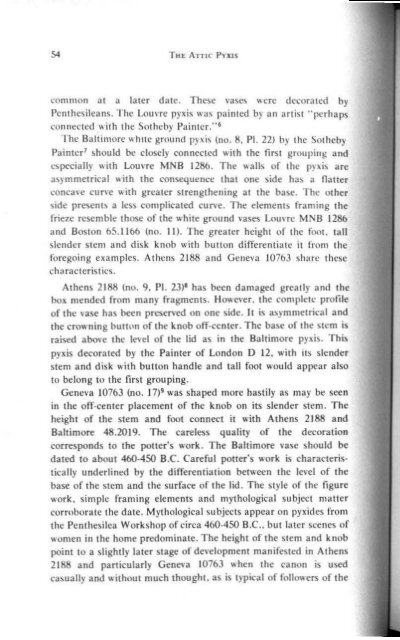Create successful ePaper yourself
Turn your PDF publications into a flip-book with our unique Google optimized e-Paper software.
54<br />
THE ATTIC Py:us<br />
common aI a later date. These vases ~crc decorated by<br />
PcnthesiJeans. The LoU\TC PYllis was painted b}' an artist "perhaps<br />
connected with the SOIhcby Painter,'"<br />
The BaltImore while ground pyxi'i (no. 8. PI. 221 by the Sotheby<br />
Painter 7 should be closely connected .....ith the first grouping and<br />
l:~pt'cially ~ith Louvre MNB 1286. The walls of the p)'xis arc<br />
as}'mmetrical \\ith the consequence that one side ha~ a flaller<br />
concan~ cun'e with greater strengthening 31 the base. The other<br />
side prescllI!o a I~ complicated CUTve. The elements framing the<br />
frieze resemble those of the white to:Tound vases Lom'rc MNB 1286<br />
.md Boston 65.1106 (no. 11). The greater height of the foot. tall<br />
slender stem and disk knob with bUllon differentiale it from the<br />
foregoing examples. Athens 2188 and Geneva 10703 share the!>c<br />
chara{"teristic~.<br />
Athens 2188 tno. 9, PI. 23)' has been damaged greatly and the<br />
box mended from many fragments. Ho",e\'er, the complete profile<br />
of the vase has been preserved on one side, It is 3:lo)'mmetrical and<br />
the cro',~.-ningbutt\ln of the knob ofT-center. The base uf the stem is<br />
raised abo\'e the le\'el of the lid as in the Baltimore pp:is. Thilo<br />
ppis decorated by the Painter of London 0 12, with Its slender<br />
stem and disk with button handle and tall foot would appear also<br />
to belong tu the first grouping.<br />
Geneva 10763 (no. 11)' was shaped more hastily as may be seen<br />
in the oO'-center placement of the knob on its slender stenl. The<br />
height of the stem and foot connect it with Athens 2188 and<br />
Baltimore 48.2019. The careless quality of the decoration<br />
corresponds to the poller's 'A'ork. The Baltimore vase should be<br />
dated to about 460-4SO D.e. Cardul polter's work is characteristically<br />
underlined by the differentiation bct\\'een the le\'el of the<br />
base of the stem and [he surface of the lid. The style of the figure<br />
work, simple framing elements and mythological subject maller<br />
corroborate the date, Mythological subjects appear on pyxides from<br />
the Penthesilea Workshop of circa 460-450 B.e., but later scenes of<br />
women in the home predominate. The height of the stem and knob<br />
point to a slightly later stage of de\'elopmem manifestcd in Athens<br />
2188 and panicularly Geneva 10763 whcn thc canon is used<br />
casually and without much thought. as is typical of followers of the<br />
potter 01 the PenthesiJea Workshop around 450-440 D.e.<br />
The \.\ hite ground pyxis in Bcrlin (no, 10, PI. 20) by the Yeii<br />
Paillter b connected by the height of ill> stem and knob and foot to<br />
the la~t mentioned !:rtlUp. A glaze line frames the frieze above and<br />
helo" and an outer frame is formed b) a black band se1 lIeXl 10<br />
each. Such framing elements arc identical '" ith those seen 011<br />
8ahimore 48.2019, Louvre MN8 1286 and BO!'iton 05.1166. The<br />
squal proponions and shon ConC3\'C cun'e of the \\alls come as a<br />
surprise. as does the widcl) proj«ting lid. The lid, hO'At'\er.<br />
assuredl) belonglo to the vase. The underside of the lid is reddened<br />
and d«orated by a dot within a small circle with a wider<br />
surrounding circle, '1 he design on the bottom of the l:onlainer<br />
matL'lleo; that undcr thl.' lid wilh the additiun of Ilnc 1Il0re outer<br />
circle. I he lid. in addition. i~ well filled to the container. The ray'<br />
ornamentlllg the outer wm'a\'e flangc of the lid ;Ire identical" ith<br />
Baltimore 48.2019.<br />
P)Xide~ of types B, C and 0 occasionally bear matching gralTiti<br />
on lid and box." '" hile pyxides of type A ne\'cr do to Ill)<br />
knolloled~c.1I HOIloe\'er, ~metimclo there are matching seb of<br />
Clln('Clllric drclelo on the underside of lid and box in type A. 1 he<br />
box almo!>t im'ariably bears these designs. When the lid bears a<br />
m:uching !>ct of circles it seems secure that box and lid bcloll!:.<br />
Ho\.\cvcr, many lids are merely rcscned, though evidencc Ill' pallem<br />
borders. eolor of clay and fit indil:atl:lo a match. The probllblc<br />
explanation lies in lhe loading of the kiln. If many pyxido ",ere to<br />
be tired in the gi\cn kiln batch. matl;hing marks on lid and box<br />
would he a convenience, \\hile if fev. there ",ould be little nct.·cloloil).<br />
Another possibilit) is the degree of care expended on the<br />
ornamcntation of a \'a~. The puller of Berlin 2201 cenainly kne\\<br />
the canon illld the ac\"'ompanying pattern accenb but experimented<br />
in a diflcrent directioll. The date lies between 460 and 450 H.C.<br />
An unallributed pyxi!>, lIoston QJ.I08 (1111. 12. PI. 27),<br />
apprual'llCk knob with bUllon on a squat stem bcarl> no<br />
resemblance 10 the elegantly executed Berlin cxample. The ha

















